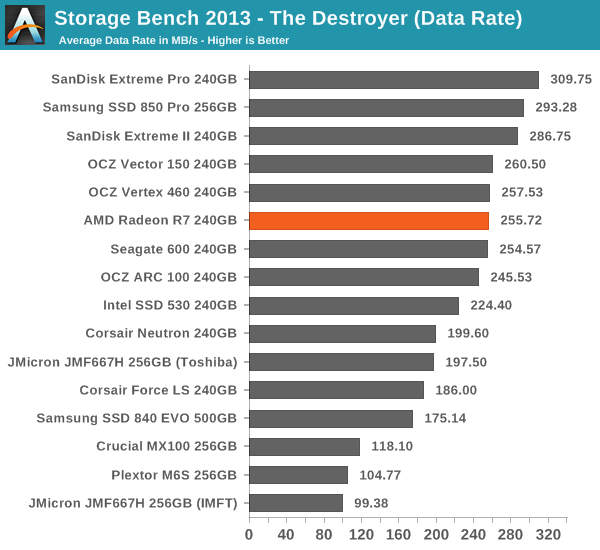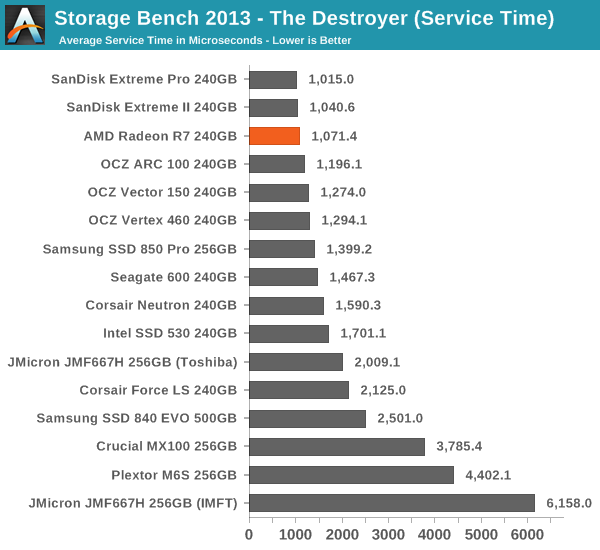AMD Radeon R7 SSD (240GB) Review
by Kristian Vättö on August 28, 2014 6:00 AM ESTAnandTech Storage Bench 2013
Our Storage Bench 2013 focuses on worst-case multitasking and IO consistency. Similar to our earlier Storage Benches, the test is still application trace based – we record all IO requests made to a test system and play them back on the drive we are testing and run statistical analysis on the drive's responses. There are 49.8 million IO operations in total with 1583.0GB of reads and 875.6GB of writes. I'm not including the full description of the test for better readability, so make sure to read our Storage Bench 2013 introduction for the full details.
| AnandTech Storage Bench 2013 - The Destroyer | ||
| Workload | Description | Applications Used |
| Photo Sync/Editing | Import images, edit, export | Adobe Photoshop CS6, Adobe Lightroom 4, Dropbox |
| Gaming | Download/install games, play games | Steam, Deus Ex, Skyrim, Starcraft 2, BioShock Infinite |
| Virtualization | Run/manage VM, use general apps inside VM | VirtualBox |
| General Productivity | Browse the web, manage local email, copy files, encrypt/decrypt files, backup system, download content, virus/malware scan | Chrome, IE10, Outlook, Windows 8, AxCrypt, uTorrent, AdAware |
| Video Playback | Copy and watch movies | Windows 8 |
| Application Development | Compile projects, check out code, download code samples | Visual Studio 2012 |
We are reporting two primary metrics with the Destroyer: average data rate in MB/s and average service time in microseconds. The former gives you an idea of the throughput of the drive during the time that it was running the test workload. This can be a very good indication of overall performance. What average data rate doesn't do a good job of is taking into account response time of very bursty (read: high queue depth) IO. By reporting average service time we heavily weigh latency for queued IOs. You'll note that this is a metric we have been reporting in our enterprise benchmarks for a while now. With the client tests maturing, the time was right for a little convergence.

Performance in our 2013 Storage Bench is typical Barefoot 3, although it appears that both the R7 and ARC 100 are more optimized for small IOs given that they provide a lower service time, yet the data rate is marginally slower.











54 Comments
View All Comments
Death666Angel - Friday, August 29, 2014 - link
Agility 1 and Vertex 2 still going strong here!mapesdhs - Saturday, August 30, 2014 - link
The key is fw updates. The old bugs are fixed. Once done, they're fine.People act like OCZ was the only company to have issues, but even Intel and
Samsung screwed up their SSD line at one point or other (FUD posters choose
to forget Intel's 8MB bricked SSD issue).
Ian.
bronan - Monday, November 9, 2015 - link
Agreed on that Death666Angel i got 12 of them all running perfect, ofcourse one day they will die :DBut this far super and still good performance for such OLD ssd ;)
On topic i like the way AMD is going open in everything no faking or hiding facts like the competition, i hope AMD keeps up the good work they are doing. Teaming up with other good brands like Toshiba and such only makes both brands better. A shame they do not have a enterprise version else i would have considered them as well
zero2dash - Thursday, August 28, 2014 - link
I'm sorry, did you just say Vertex/Agility were reliable? Is it opposite day or something?I owned a 30 GB Vertex. It was great for 10 months. Then it started throwing up chkdsk errors. Sanitary Erasing did nothing but "buy some time". I had it replaced several times under warranty. Then they put out a FW update that turned Vertex's into Vertex Pros (probably in an effort to look less terrible with mud on their faces). I flashed mine, sanitary erased it again, and sold it for peanuts (almost literally) and got a Crucial M4 SSD that has been rock solid for several years now.
As far as I'm concerned, OCZ can close their doors for good. Or don't, I could care less because I'm never purchasing another OCZ product ever again.
Homeles - Thursday, August 28, 2014 - link
Their Octane/Petrol failure rates were close to 50%.ProfSparkles - Friday, August 29, 2014 - link
At my company we go through many SSDs per year and by now we lost every single OCZ SSD (mostly Vertex 3) we bought so far and had to replace it, at first we use the warranty and replaced it with yet another OCZ but when those failed aswell we bought new Samsung SSDs (840 EVO) which was less expensive than driving to customers another time and replacing the failed drives. The Samsungs drives already tripled the OCZ drives lifetime.I personally own a first batch Vertex 2 which still works well but since the rev 2 of the Vertex 2 and Vertex 3 they went so far downhill its just ridiculous.
mapesdhs - Saturday, August 30, 2014 - link
Blah blah. Fact is, none of that applies to the non-Sandforce models, and I've had no
issues with the pile of V3 MXIs I bought; guess you were just unlucky.
Ian.
dragonsqrrl - Thursday, August 28, 2014 - link
... I think he's referring to their SSD's.Guspaz - Thursday, August 28, 2014 - link
Bought a bunch of OCZ RAM. It failed (or at least some sticks did) and they got out of the RAM business so they invalidated the warranty. Convinced a friend to buy a Vertex 2 before they got their bad rep. It failed. He got a replacement. It failed. He got a replacement. It failed. He bought an Intel. It didn't fail.Sorry, but a company with such unreliable products getting bought out by Toshiba (who lied to me and refused to honour their warranty) just makes them even more of a "not with a ten foot pole" in my books.
Sparrowgryphon - Monday, March 7, 2016 - link
I just had this SSD fail last night, it was about 4 months old. put it in a different PC will not show up and even stops the PC from booting.